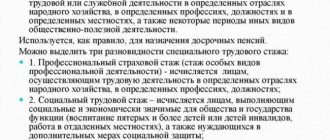What it is
Compulsory pension insurance is a set of legal, economic, coordination measures developed by the state, which is aimed at compensating citizens of the country for any types of earnings that they previously had before the start of retirement age.
Insurance subjects include government bodies at various levels from federal to local administrative centers, policyholders, insurers, and insured persons.
Pension insurance is called compulsory if it operates legally by involving all categories of the country's population in it. There are state and non-state pension funds operating in the country, which provide pensions.
The organizational structure for assigning pensions that has developed in the Russian Federation is divided into:
- compulsory pension provision, which is assigned in the event of old age, disability, or loss of a breadwinner;
- voluntary, covering pensions paid through contributions paid by employers together with independent pension savings of citizens.
Non-state pension funds are given the right to operate under both structures.
Pension security is a monetary benefit represented by a set amount that is regularly paid by the state to a recipient who has reached a certain age or upon completion of employment as a benefit.
The pension is paid from the time when the above events occur until the end of life.
It is divided into parts:
- basic or social, it is paid by the state regardless of the salary received, the amount of insurance contributions paid to all persons who have reached retirement age and have a minimum work experience of five years;
- insurance, depending on the amount of payments made to the Pension Fund under the insurance contract while the labor activity lasted. It is calculated as the ratio of the pension capital accumulated before the day the pension was assigned and the number of months of waiting for payments, which is equal to 228 months or 19 years;
- funded, which is influenced by accumulated pension contributions, was introduced in 2002, so younger age categories of citizens can apply for it, for example, it is issued to men from 1953 to this year of birth, and to women, starting from 1957.
Federal Law on Compulsory Pension Insurance
The regulation of the procedure in the Federation by the state is based on the norms of the Federal Law, issued in December 2001, number 167-FZ, which defines the legal role of the subjects, the regulations of their legal relations, the grounds for their emergence and methods of exercising rights and obligations, and the level of responsibility of each subject is noted.
The Federal Law “On Compulsory Pension Insurance”, adopted in 2002, made it possible to implement a pension reform, according to which citizens of the country had to become insured persons.
It provided for the opening of individual personal accounts for citizens with insurance, where the employer regularly transferred insurance premiums every month in his favor when calculating wages. These payments accumulate, forming a future pension for work activities.
Insurance premiums in the personal account are invested in the financial market, due to which a certain additional amount is formed, which is added to the accumulated funds.
The savings part is at the full disposal of the State Management Company, which keeps it in the current account of Vnesheconombank. Every citizen in the Russian Federation has the right to dispose of the funded part of the pension at his own discretion, and he also determines the method of investment.
If there are no proposals from him for the use of accumulated funds, then they are transferred from the Pension Fund to the account of the State Management Company. However, a citizen has the right to make a contribution to a non-state foundation, transferring to it the rights to trust management.
A lifelong pension will be paid to a citizen of the Russian Federation upon reaching the retirement age. It will include accumulated funds and income received as a result of their subsidies.
Manage your money
How are pension savings formed?
The employer transfers insurance contributions to the Pension Fund - 22% of the employee’s salary. Until 2014, 6% of them replenished their pension savings account with the Pension Fund of the Russian Federation/NPF. Since 2014, the savings account has been “frozen” and 22% of insurance premiums form an insurance pension in the Pension Fund.
You can only manage a savings account; it forms a funded pension for citizens born in 1967 and younger. The funded pension will complement the insurance pension and its advantage is that it is assigned 5 years earlier. Despite the fact that insurance premiums no longer replenish the savings account, it grows due to the profitability of the fund accrued annually. Provided that the fund does not show negative or zero returns.
How are pension savings transferred?
It is very important to choose a profitable and reliable pension fund. The savings account can be left with the Pension Fund or transferred to a non-state pension fund, for example, NPF Bolshoy. NPF "Bolshoi" has been operating for 26 years, fully fulfilling its obligations and showing excellent profitability.
The transition can be urgent or early. In case of early transfer from fund to fund, no matter to the state Pension Fund or Non-State Pension Fund, the client loses part of his pension savings. More details here.
There are no losses during an urgent transition. The application for the transfer itself must be submitted to the new fund before the end of November; during December, the citizen is informed about the transfer, and he can cancel it. The transfer of the client with the transfer of the funded pension account is carried out automatically at the beginning of the next year.
How are pension savings invested?
The investment strategy of NPF Bolshoi is aimed at achieving long-term profitability goals. “Bolshoi” strives, on the one hand, to ensure the safety of pension savings, and on the other, protection from inflation. By law, at least 85 percent of the income received by the fund from investing pension savings must be used to replenish pension savings not included in the fund’s reserves. This is done after deducting the remuneration of the management company and the specialized depository.
How are pension savings inherited?
The funded part of the pension is inherited by legal successors in the event of the client’s death before the pension is assigned. You can determine legal successors yourself or they will automatically become heirs of the first or second stage.
What taxes and what tax deduction can I get?
Citizens who pay additional contributions to a funded pension from their own funds can claim a social tax deduction. Additional employer contributions are not included in the tax deduction calculation. State pensions are not subject to personal income tax, with the exception of payments if an individual has a voluntary replenishment of the funded part of the pension.
Functions
Compulsory pension insurance, as part of the pension system of the Russian Federation, performs functions that make it possible to protect citizens in cases of insurance risks.
It is carried out by the Pension Fund, which performs the functions of an insurer, whose responsibilities include:
- exercising control over the correct calculation of insurance premiums and their timely transfer to the Pension Fund in full;
- appointment and implementation of timely payments for all types of insurance pensions, taking information from an individual account as a basis;
- verification of documents for accrual of compulsory insurance coverage;
- drawing up a draft PF budget and ensuring its implementation;
- ensuring the targeted use of financial resources;
- accounting for incoming finances;
- registration and deregistration of policyholders;
- monitoring the receipt of insurance premiums from individuals who voluntarily entered into legal relations;
- creation of a state database on various groups of policyholders;
- providing regulations that allow maintaining a special part of an individual account;
- ensuring the organization of timely accounting of income received from investing funds;
- free consultations at all levels of regional bodies of insured persons and policyholders;
- accepting applications from individuals to voluntarily enter into legal relations;
- consulting, informing insured persons regarding the payment of additional contributions, posting information on the official website of the Pension Fund, the media;
- performing the functions of a personal data operator;
- determination of the amount of insurance payments accrued to the insurance and funded parts of pensions.
How voluntary pension insurance differs from compulsory one, find out from the article: voluntary pension insurance.
Read about the main functions of the Social Insurance Fund of the Russian Federation here.
Functions of compulsory pension insurance
Compulsory pension insurance is a way to protect citizens from emerging risks associated with the onset of disability. The role of the insurer in this system is the Pension Fund of the Russian Federation.
The modern pension insurance system, defined by 167 Federal Law “On Compulsory Pension Insurance,” performs two main functions:
- social function;
- stimulating function.
The social purpose of the system is to provide a decent standard of living to disabled citizens. This function is implemented not only through the payment of a fixed benefit, but also through a regular increase in the insurance pension and provided social benefits for those in need.
The essence of the incentive function is that a citizen can independently influence the size of his future pension. When calculating it, length of service is taken into account, as well as the amount of insurance premiums paid during life.
What goals are being pursued?
The main goal is to provide citizens of retirement age with a decent standard of living, for which conditions are created for them to have an additional pension.
State bodies, together with non-state pension funds, have developed a number of special programs that are focused on the introduction, improvement and development of mechanisms for implementing pension insurance.
Compulsory pension insurance programs are attractive because they have flexible regulatory conditions that can be implemented easily and quickly according to the requests of a specific insured person.
Its advantages are:
- if the period during which the accumulation is made ends, then the accumulated funds can be withdrawn in full or received in equal monthly installments for the rest of your life;
- if the insured person dies before the end of the accumulation period, then they are transferred to the heirs;
- if the insured person is unable to make contributions for any period of time, then the amount of the future pension is recalculated depending on the amount accumulated until the suspension of payments;
- If the insured person dies, the successor is paid the funds collected up to that time. The payment deadline is specified in the contract or when amendments are made to it, but before payments begin.
OPS Agreement
The OPS agreement stands for compulsory pension insurance agreement. It is a legal document between the insurer and the insured person, as a result of which one party transfers his funded pension to the control of the other party. This agreement is evidence that a citizen, a participant in the OPS system, becomes a client of a non-state pension fund (NPF).
Who has the right to enter into an OPS agreement?
All citizens who are officially employed in the territory of the Russian Federation, on account of which insurance premiums are made, are of legal age (younger than 1966), have the right to sign a compulsory insurance agreement with any non-state pension fund that is included in the DIA register.
After concluding a compulsory security agreement (sometimes also called a compulsory security certificate), the Pension Fund transfers all accumulated funds to the management of the non-state pension fund chosen by the person. In this case, the non-state pension fund assumes the right to invest the pension savings of its client and subsequently bring him income from investment activities. Only those non-state pension funds that have passed the inspection of the Central Bank and are included in the system of guaranteeing the rights of insured persons can invest in the compulsory pension insurance system. According to the new legislative conditions, all pension funds are joint-stock companies and can invest pension funds only in those financial instruments that are strictly regulated by law.
As described in the contract
A pension insurance contract is an agreement concluded by a pension fund and the policyholder in the interests of the insured person or his legal successor, according to which the fund undertakes to assign and pay to him upon reaching retirement age the cumulative part of his labor pension or to make payments to his legal successors in the event of his death.
The agreement describes:
- rights and obligations of the Pension Fund, the insured person;
- accounting for savings received from the insured person and their subsidies;
- regulations, conditions of appointment, making payments from the funded part of the labor pension;
- the procedure for issuing the savings of a deceased insured person to legal successors;
- liability of subjects for committed offenses related to the fulfillment or improper fulfillment of obligations assigned to them by agreement in accordance with the norms of the legislation of the Russian Federation;
- the procedure for introducing amendments, requirements for termination;
- duration of validity.
The agreement takes legal force from the day when the funds transferred by the former insurer arrive at the current account of the selected fund. The pension insurance agreement is one of the types of personal, it is two-sided and non-generalized.
In addition, it is necessary to note the personal data of the insured person, information about the nature of the insured event, the amount of the insurance amount, and details.
Sample agreement on compulsory pension insurance between a non-state pension fund and the insured person.
A completed sample agreement on compulsory pension insurance between a non-state pension fund and the insured person.
The new standard rules of the Central Bank provide for the remote conclusion of an agreement on the transfer of pension savings to a non-state pension fund (NPF). Currently, several formal restrictions stand in the way of NPFs completely abandoning physical contact with clients, but they can be eliminated. If this happens, the market will face a rapid increase in the rate of acquisition with all the aggravating consequences for clients, experts believe.
At the end of February, the Bank of Russia published new standard insurance rules for non-state pension funds. One of the innovations is the possibility of concluding an agreement on compulsory pension insurance (OPI) between the fund and the client by exchanging electronic documents “via communication channels that make it possible to reliably establish that the agreement comes from the parties to the agreement,” that is, via the Internet. The possibility of remote electronic conclusion of an agreement, for example on the NPF website, was confirmed by the Central Bank.
According to current regulations, a non-state pension fund is obliged to notify the Pension Fund of Russia (PFR) within one month about the agreement on compulsory pension insurance it has concluded, including submitting “a copy of the newly concluded agreement.” In private funds interviewed by Kommersant, this provision is interpreted as providing a document in paper form. However, despite this provision, in the past NPFs have already concluded electronic agreements on OPS with their clients, the Accounts Chamber (AC) indicated, naming, in particular, NPF Sberbank, Khanty-Mansiysk NPF and Akvilon. A top manager of another large fund, which also collected electronic contracts, indicates that they were submitted to the Pension Fund through certification centers (CA), but this possibility was excluded in 2021. The joint venture called the practice of concluding an electronic agreement on compulsory pension funds contrary to the law “On Non-State Pension Funds”.
The Pension Fund of the Russian Federation refused to comment on what legal acts it accepted documents in electronic form and whether it would accept such documents now. “The exchange of information between NPFs and the Pension Fund is carried out in the manner established by the government, in electronic form using the system of interdepartmental electronic interaction (SMEI),” the Central Bank responded to the question of how the agreement will be submitted in electronic form to the Pension Fund. “We are ready to switch to drawing up a paperless contract with the insured person,” said Sberbank NPF Operations Director Viktor Polyakov. As the operating director of NPF Safmar, Alexandra Lutchenko, hopes, the norm on submitting an agreement to the Pension Fund in paper form “will also be changed, as a result of which funds will be able to enter into agreements electronically through the website.”
However, there is another factor that prevents the establishment of a fully digitalized remote transfer of pension savings - this is the need to submit, in addition to the contract, an application for the transfer. It can be submitted in paper form (either by the citizen himself or his representative) or electronically through the Unified Public Services Portal (UPSP) only using an enhanced qualified electronic signature (CES), which is generated by the CA. A minority of citizens have their own CEP, but agents can help in its formation in cooperation with the CA. However, according to the counterparty of several NPFs, to do this, the agent must in any case sign a paper power of attorney with the client, where he agrees that the agent will use the services of a CA to issue him a CEP.
Previously, large banking groups - Sberbank, VTB, FC Otkritie - lobbied for the transition from CEP to a simple electronic signature (PES), and they almost managed to achieve such a government decision (see Kommersant of December 14, 2021). However, it was decided to keep the qualified signature and return to the issue of using a simple signature later, after finalizing the EPGU. If the Pension Fund returns to the practice of accepting an electronic contract, and it also becomes possible to use a simple signature, the transfer of pension savings will be significantly simplified. And it will increase the chances of implementing the plans of NPF Sberbank, NPF Otkritie (see Kommersant on January 24) and VTB Pension Fund to collectively collect more than 4 million contracts this year.
“If the possibility of remote submission of a contract and application is freed from paperwork and extremely simplified, and also does not require live contact with a person, then, of course, we should expect even such ambitious plans to be revised upward,” says Managing Director of Expert RA Pavel Mitrofanov. In particular, he said, many financial institutions with a wide customer base will be able to use access to it for remote sales of mandatory security, which will further spin the flywheel of the transition campaign. “And we will be able to see again the rapid pace of attracting clients, but with all the aggravating circumstances in the form of illegal transfers and mass loss of money by citizens due to early transfer,” the expert believes.
Ilya Usov
Persistence and agents
The authority to approve standard insurance rules for non-state pension funds was transferred to the Central Bank in September 2013. However, for almost five and a half years the regulator did not touch them. The current clarifications were made “in connection with the requirements of the law and existing law enforcement practice,” the Central Bank said. In the new document, in particular, along with the variable part of the remuneration (depending on the investment income received), the constant part of the remuneration (depending on the amount of assets) is also taken into account (see “Kommersant” dated May 22, 2021). Currently, the insurance rules of NPFs include management fees in accordance with the recommendations of the Central Bank. Also, the new rules spell out the liability of NPFs for non-fulfillment or improper fulfillment of obligations by their agents, which the Central Bank has long insisted on (see Kommersant of June 6, 2021). The document will come into force after the Ministry of Labor cancels the previous insurance rules adopted in 2010 by the Ministry of Health and Social Development. “Funds are required to bring their rules into compliance with the instructions within one year from the date of its entry into force,” the Central Bank noted.
Ilya Usov
Risks and cases
The current Federal Law defines the concepts of “insurance risk” and “insured event”. In accordance with it, insurance risks include the loss of earnings by the insured person in the form of payments, rewards or other types of income upon the occurrence of an insured event.
An insured event is an event specified in the contract that has occurred, therefore the insurer is obliged to make an insurance payment to the insured person or his successor.
These include events or a combination of them:
- the arrival of retirement age;
- disability due to illness, traffic accidents;
- loss of a person who is the sole breadwinner.
As for the benefits received by the person insured under the pension insurance program, they undoubtedly exist.
First of all, they consist of providing the services of a personal consultant who explains the intricacies and nuances of pension insurance. Secondly, to attract and retain valuable personnel, most employers enter into a corporate insurance agreement to provide a pension, while receiving tax benefits.
Why you need an insurance certificate is described in the article: insurance certificate of compulsory pension insurance. Find out how the compulsory pension insurance system functions in the Russian Federation in this article.
Read about the legal basis of social insurance here.








